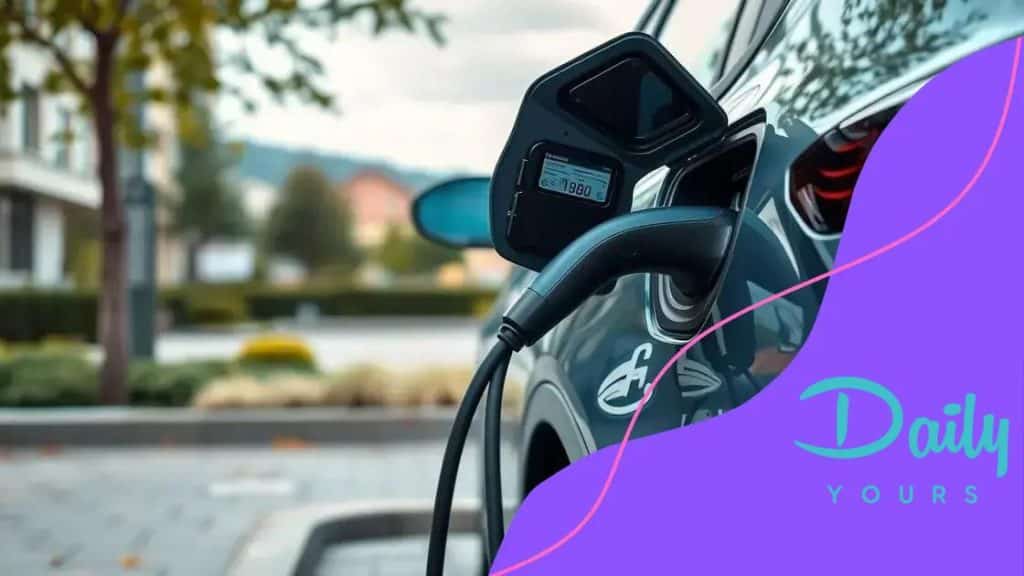The rise of electric vehicles and their impact on the environment

Anúncios
The rise of electric vehicles significantly reduces greenhouse gas emissions and enhances air quality, supported by government incentives and advancements in battery technology, while facing challenges like charging infrastructure and higher upfront costs.
The rise of electric vehicles is not just a trend; it’s a shift towards a more sustainable future. Ever wondered how this revolution affects our planet’s health? Let’s dive in!
Anúncios
Understanding electric vehicles and their technology
Understanding electric vehicles (EVs) and their technology is essential for grasping how they operate and their benefits. Unlike traditional cars that use internal combustion engines, EVs are powered by electricity stored in batteries. This technology enables them to operate more efficiently and with fewer emissions.
The Basics of Electric Vehicle Technology
At the core of EV technology are a few key components: the electric motor, the battery pack, and the charging system. The electric motor converts electrical energy into mechanical energy, propelling the vehicle forward. Meanwhile, the battery pack stores this energy, allowing for longer travel distances between charges.
Types of Electric Vehicles
There are primarily three types of electric vehicles:
Anúncios
- Battery Electric Vehicles (BEVs): These run entirely on electricity.
- Plug-in Hybrid Electric Vehicles (PHEVs): These have both an electric motor and a traditional engine.
- Hybrid Electric Vehicles (HEVs): These use a combination of a regular engine and a battery but cannot be charged from an external power source.
This diversity allows consumers to choose an EV that best fits their lifestyle and driving habits. The development of charging infrastructure has also accelerated the rise of EVs, with many public charging stations now available. More than ever, potential drivers can find charging options in urban and rural areas alike.
Innovations in Electric Vehicle Technology
Recent innovations in battery technology are also changing the game. With advancements, newer batteries are lighter, charge faster, and provide greater range. Companies are now exploring solid-state batteries that promise even better performance and safety. The widespread adoption of EVs plays a significant role in reducing overall carbon footprints.
In addition, many EVs come equipped with smart technologies that enhance the driving experience. Features like regenerative braking, advanced navigation systems, and real-time battery monitoring help improve efficiency and user convenience.
As consumers become more aware of environmental issues, the demand for electric vehicles will likely continue to grow. The technology behind these vehicles is evolving rapidly, making them not only more appealing but also more practical for everyday use.
Environmental benefits of electric vehicles
The environmental benefits of electric vehicles (EVs) are significant and impactful. By transitioning from gasoline-powered cars to EVs, we can make a noticeable difference in reducing our carbon footprints.
Reduction in Greenhouse Gas Emissions
One of the primary advantages of EVs is their capacity to lower greenhouse gas emissions. Unlike traditional vehicles that emit harmful gases, electric vehicles run on electricity, which can be generated from renewable sources. This shift can substantially decrease the amount of carbon dioxide released into the atmosphere.
Improvement in Air Quality
Electric vehicles also help improve air quality in urban areas. Gasoline and diesel vehicles release pollutants that contribute to smog and health issues. By using EVs, cities can reduce these pollutants, leading to cleaner air and a healthier population.
- Increased use of renewable energy sources.
- Lower levels of particulate matter.
- Enhanced overall public health.
The quiet operation of EVs is another aspect that contributes to environmental quality. They produce far less noise pollution compared to conventional vehicles, making urban environments more pleasant.
Sustainable Resource Usage
The production of EVs encourages sustainable practices. Manufacturers are increasingly utilizing recycled materials in their vehicles, promoting a circular economy. Additionally, the shift towards electric technology drives innovation in battery recycling and sustainable sourcing of materials.
As a result, electric vehicles not only reduce emissions but positively influence entire industries. Ultimately, investing in EV technology encourages broader changes in how we think about transportation and resource use.
With advancements in technology, the lifecycle of electric vehicles becomes even more eco-friendly, further emphasizing their importance in combating climate change.
Challenges in adopting electric vehicles

Despite the many benefits of electric vehicles (EVs), there are several challenges that consumers and manufacturers face when it comes to adoption. Understanding these challenges is crucial for making informed choices.
Limited Charging Infrastructure
One of the primary hurdles is the limited availability of charging stations. While the number of charging points is increasing, many areas still lack sufficient infrastructure. This can create range anxiety for potential EV buyers, who fear running out of power during a trip.
Higher Initial Costs
Another challenge is the higher upfront cost associated with purchasing an electric vehicle. Although prices are gradually decreasing, many EVs still come with a premium when compared to traditional gasoline-powered cars. This initial investment can deter potential buyers, even though lower operating costs may offset this over time.
- Electric vehicles often have a higher cost of entry.
- Incentives and rebates can help reduce the financial burden.
- Long-term savings on fuel and maintenance are notable.
Furthermore, technology continues to evolve, meaning that new models frequently enter the market. Consumers might hesitate to invest in the latest EV technology, worrying that it may quickly become outdated.
Battery Life and Environmental Concerns
Battery technology also presents challenges. While advancements are being made, concerns about battery longevity and end-of-life disposal remain. The production and recycling of batteries can have significant environmental impacts, which raises questions about the overall sustainability of electric vehicles.
As battery technology improves and recycling methods become more efficient, these concerns are likely to be addressed, paving the way for broader adoption. Nonetheless, the conversation around these issues continues to be relevant.
Lastly, consumer knowledge and perceptions significantly affect EV adoption. Many people are still unaware of how electric vehicles work or their various benefits, leading to misconceptions. Education on these vehicles can play a key role in overcoming resistance to change.
The role of government incentives in EV development
The role of government incentives in electric vehicle (EV) development is crucial. These incentives help lower the financial barriers for consumers and encourage manufacturers to invest in EV technology.
Financial Incentives for Consumers
Many governments offer various financial incentives to promote the purchase of electric vehicles. These can include tax credits, rebates, and grants. By reducing the initial cost, these incentives make EVs more accessible to a broader range of drivers.
- Tax credits: Consumers can receive a significant tax break when purchasing an EV.
- Cash rebates: Some states and local governments provide direct cash rebates after the purchase of an electric vehicle.
- Low-interest loans: Financial institutions may offer low-interest loans for EV purchases, making them more affordable.
These measures not only encourage buyers but also increase overall EV adoption rates. As more people invest in electric vehicles, the shift towards sustainable transportation accelerates.
Support for Charging Infrastructure
In addition to financial incentives, government programs often focus on developing charging infrastructure. Investments in public charging stations are essential for alleviating range anxiety. With more charging options, consumers feel more confident in their ability to own and operate an EV.
Subsidizing the installation of home chargers can also play a key role. Many homeowners may consider purchasing an electric vehicle if they can conveniently charge it at home without high installation costs. Government support helps make this a reality.
Research and Development Funding
Government incentives extend to research and development as well. Funding for innovation in battery technology and EV manufacturing can lead to significant advancements. These investments can further reduce costs and improve performance, making electric vehicles even more appealing.
As companies innovate and develop new models, market competition increases, which could lead to lower prices and improved capabilities of electric vehicles.
Overall, government incentives create an environment where electric vehicles can thrive. By making them financially viable and improving supporting infrastructure, governments play a pivotal role in the transition to a sustainable future.
Future trends in electric vehicle technology
The future trends in electric vehicle technology are exciting and hold great promise for sustainable transportation. As the industry evolves, numerous innovations are expected to shape how we understand and use electric vehicles.
Advancements in Battery Technology
One of the most significant trends is the improvement of battery technology. Researchers are working on developing solid-state batteries that can provide greater energy density and faster charging times. This technology could enhance the overall performance of electric vehicles.
Moreover, new materials like lithium-sulfur and graphene-based batteries are being explored to increase battery lifespan and reduce costs. These innovations will make electric vehicles more practical and appealing to a broader audience.
- Longer driving ranges are becoming achievable.
- Faster charging stations are being developed worldwide.
- Recycling methods for batteries are improving.
Integration of Smart Technologies
Another trend is the integration of smart technologies into electric vehicles. As cars become more connected, features like autonomous driving, advanced navigation systems, and vehicle-to-grid technology are emerging. These smart technologies help optimize energy usage and enhance the driving experience.
With autonomous driving, EVs will be able to navigate themselves safely. This reduces the need for human intervention and can improve overall traffic efficiency. Additionally, vehicle-to-grid technology allows electric vehicles to feed energy back into the grid, supporting renewable energy sources and stabilizing energy demand.
Focus on Sustainability
There’s an increasing focus on sustainability in the production and lifecycle of electric vehicles. Manufacturers are exploring ways to reduce their carbon footprints, from sourcing materials sustainably to using eco-friendly production methods. This trend signifies a commitment to not only producing electric vehicles but doing so in a way that supports the environment.
Furthermore, the adoption of renewable energy in the manufacturing process is becoming more common. This shift ensures that electric vehicles remain a clean alternative as the world moves towards greener solutions.
In summary, the future of electric vehicle technology promises exciting advancements. With improved batteries, increased smart technology integration, and a stronger commitment to sustainability, the electric vehicle market is set to grow rapidly.
In conclusion, the rise of electric vehicles signifies a pivotal shift towards sustainable transport. With advancements in technology, government incentives, and growing consumer awareness, electric vehicles are becoming more appealing. Addressing challenges like charging infrastructure and battery technology is crucial for the continued growth of this market. As electric vehicles evolve, they promise cleaner air, reduced carbon footprints, and a brighter future for our planet. The journey toward widespread EV adoption is underway, and it holds the potential to transform how we think about transportation.
\n\n
\n
FAQ – Frequently Asked Questions about Electric Vehicles
What are the main environmental benefits of electric vehicles?
Electric vehicles (EVs) reduce greenhouse gas emissions and improve air quality by emitting no tailpipe pollutants.
How do government incentives affect the electric vehicle market?
Government incentives, such as tax credits and rebates, make electric vehicles more affordable and encourage consumer adoption.
What technological advancements are occurring in electric vehicles?
Significant advancements include improved battery technology, faster charging times, and the integration of smart features like autonomous driving.
What challenges do consumers face when adopting electric vehicles?
Consumers often face challenges such as limited charging infrastructure, higher initial costs, and concerns about battery lifespan and disposal.





